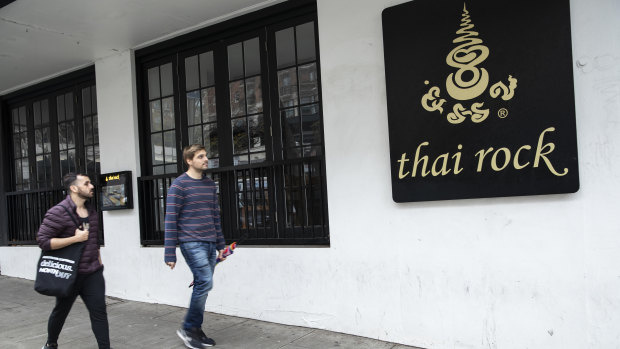This was published 4 years ago
Supercluster confirmed as genetic fingerprint links two outbreaks 34km apart
By Kate Aubusson and Pallavi Singhal
Two of Sydney's mystery COVID-19 clusters are in fact one supercluster, with NSW Health confirming the Thai Rock Restaurant outbreaks are genomically linked.
More than 34 kilometres separate the two Thai Rock eateries, but an analysis by NSW Health found their cases share a close genomic fingerprint, unequivocally fusing the two clusters which, combined, account for 153 COVID-19 cases.
The latest NSW COVID-19 surveillance report reveals whole-genome sequencing of the Thai Rock Potts Point cases "cluster with cases from Thai Rock Wetherill Park".
NSW Chief Health Officer Dr Kerry Chant indicated she suspected a link between the two clusters several weeks ago but was waiting on the results of the genomic sequencing to confirm it. Just how the virus spread from the Wetherill Park restaurant to its Potts Point counterpart is still unknown.
"[T]his is under investigation," a spokesperson for NSW Health said in a statement.
The daily COVID-19 case counts have eased in recent days. On Tuesday, NSW recorded three new cases - one in hotel quarantine and two locally acquired, including one whose source is under investigation.
It's the lowest daily total since the state recorded two cases on July 11, and the fifth day in a row of single-digit increases.
The Thai Rock restaurants cluster is NSW's biggest since Victoria's hotel quarantine breaches foisted a second wave upon both states.
The combined tally is more than twice the size of NSW's second-largest cluster, linked to funerals held in the Bankstown area in July (73 cases), and 20 cases shy of tripling the Crossroads Hotel cluster (58 cases).
The Wetherill Park cluster was first identified when a staff member and a diner both tested positive for the COVID-19 virus SARS-CoV-2 and both had attended the restaurant during their incubation period.

The two Thai Rock restaurant clusters are now considered to be a supercluster.Credit: Louie Douvis
"While it is likely that the staff member was infected at the restaurant the source of her infection remains unknown," NSW Health's surveillance report said.
"No additional cases were identified in restaurant attendees and the quarantine period for those who attended the restaurant at a time when a case was known to be infectious ended on 26 July," the report said.
But the virus had already spidered out into a network of secondary clusters beyond the Thai Rock restaurant, racking up another 32 cases by August 1.
The Wetherill Park cases were traced to two places — Our Lady of Lebanon Cathedral in Harris Park and an under-6s soccer match in the Canterbury-Bankstown area.
The source of that soccer match cluster was a five-year-old who was a household contact of someone in the cathedral cluster. The child attended a mini-soccer training session on July 22 while infectious and didn't go to the game three days later. But the boy's father, two of his teammates and one parent of each of these children also tested positive.
The virus had ample opportunity to spread when the teammates car-pooled to practice, as well as within their own households.
At least four further cases had occurred in other household contacts by August 8.
The Thai Rock Restaurant in Potts Point first came on the radar of contact tracers when a person in central Sydney tested positive for COVID-19 on July 22 but had no contact with any other known cases of clusters at the time.
They had been to the Thai restaurant five days earlier. Another five days after this case was identified, a staff member at Apollo Restaurant, 600 metres up the road, tested positive.
At least four further cases had occurred in other household contacts by August 8.
Following media alerts urging staff and attendees of both restaurants to get tested, a couple who had eaten at Thai Rock on July 17 and Apollo on July 22 was identified as the link between the venues. One was infectious when they visited Apollo.
By August 8, 10 more cases were linked to the Apollo restaurant cluster, including six restaurant attendees and four household contacts of restaurant attendees.
But all NSW clusters linked to Victoria's second wave were dwarfed by the Ruby Princess cluster of 712 passengers, 202 crew and 62 other people — secondary and tertiary cases who never set foot on board the ship.
The COVID-19 outbreak at North West Regional Hospital (NWRH) in Tasmania found that the original source of the then 114 reported cases was most likely to have been one or both of two Ruby Princess passengers who were admitted to the hospital with COVID-19.